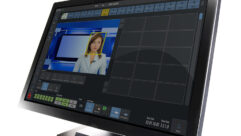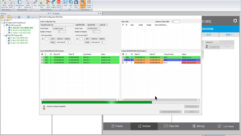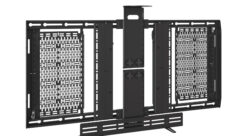Will My Surge Suppressor Work?: With the U.S. government surge suppressirclassification system, we finally have a rational basis for selection.
Sep 1, 1997 12:00 PM,
J. Rudy Harford
When you buy a new audio component or system, you immediately check to seeif you are pleased with the performance. How will you check a new powerlinesurge suppressor?
This article discusses surge suppressor classification and performanceverification developed by the U.S. government for its own needs. We willalso discuss how you can take advantage of the government’s work and howMOV technology and series-mode technology compare against the performancecriteria established.
Effective protectionAlthough the need for power-line surge protection and noise filtering maybe obvious, a serious surge could prove your protection inadequate. How canyou be sure of your protection?
Fortunately for all of us, the U.S. government had the same problem.Fortunately because they actually provided the means to fix the problem.They developed Performance Verification Testing to supplement the UL safetytesting. This performance testing classifies products according todemonstrated performance based on tests done at an independent testinglaboratory. Underwriters Laboratories (UL) was chosen for this performancetesting because the company has the necessary specialized equipment (itssurge generators cost about $70,000) and trained specialists to operatethis equipment, which UL also uses to perform safety testing.
The government classification system is based on the needs of the user anddoes not rely on any particular suppressor technology to describe theproduct tests, making it universally applicable. The system is so basic itcan be used by everyone. Just understand the following fundamental issuesand you can’t go wrong.
Endurance (reliability): Defined in three grades – A, B and C.
Performance: Defined as class 1, 2, or 3 within each grade.
Application: Modes 1 and 2 are defined, recognizing differences insuppressor design that affects proper application of the suppressors. Thisis especially important for audio and video applications.
Safety: A suppressor design must be tested and certified to UL 1449. UL1449 is the safety standard for power-line surge suppressors. Because thegovernment standard also calls for filtering performance, the design mustalso meet the UL 1283 (filter) safety standards.
Certification: Responding to government and industry needs, UL hasdeveloped a performance testing service called the Adjunct ClassificationTesting Service. At the request of the manufacturer, UL will attach theperformance test results to the manufacturers’ standard UL 1449 safetytesting records. This new testing service will test and certify performanceto the new government performance verification standards. The UL1449 safetytesting done by UL does not assure any level of performance or endurancefor any particular application – only safety. This new aAdjunct testing isnot performed by UL unless specifically requested by the surge suppressormanufacturer. Of course, manufacturers of quality products will haverequested this service and will readily supply you with the testinformation.
To establish a product endurance grade, a surge suppressor is tested with1,000 surges, using industry standard waveforms.
Grade A: 6,000 V, 3,000 A.
Grade B: 4,000 V, 2,000 A.
Grade C: 2,000 V, 1,000 A.
The performance class is also determined during the endurance testing. Aclass 1 product “suppressed voltage” (sometimes called let-through voltageor effective clamping voltage) must be less than 330 V. A recent study hasshown that class 1 performance (less than 330 V suppressed voltage at thedesign surge current) is required to protect equipment that uses aswitch-mode power supply. A Class 2 product suppressed voltage is greaterthan 330 V but less than 400 V. A Class 3 product suppressed voltage isgreater than 400 V but less than 500 V.
Two modes are defined. The proper mode to use depends on your applicationand is important. Using the wrong mode may do more harm than good! Mode 1protects line to neutral, avoiding ground wire contamination (oftendescribed as L-N, or line to neutral suppression). Note that the termsground wire, safety ground wire and ground wire circuit make reference tothe green equipment grounding wire. Mode 2 products divert surges to thesafety ground wire, thus contaminating this voltage reference wire withsurges (often described as all three modes, L-G, L-N, N-G).
Although this government classification system was introduced in 1996,manufacturers of safe, effective products moved swiftly to embrace it. Manysuppressors have been qualified to the highest Classification of class 1,grade A, mode 1, in 1996 and 1997.
The graph shown in Figure 1 compares the government performanceverification testing with UL 1449 (surge suppressor safety) and new CSA(Canadian) requirements, showing that the limited number of low-levelsurges applied during safety testing are too few and at too low a level togive a useful indication of product endurance.
The Grade A, B and C classification system is based on the AmericanNational Standard ANSI C62.41-1991 (formerly IEEE 587) as shown in Table A.Performance class, shown in Table B, is based on UL 1449 SVR (suppressedvoltage ratings) categories.
Which mode do you need?Mode is extremely important. You should select the mode carefully to meetyour application. Mode 1, the most versatile mode, can be used for aninterconnected or stand-alone environment. If two or more pieces ofequipment are interconnected with a cable other than the power wire (videocable, printer cable, audio cable, network cable, phone line) and theequipment is not all connected to the same power outlet receptacle, mode 1should be used.
Mode 2 should be used for stand-alone applications, where all equipmentshares a common power outlet receptacle or no interconnecting wires areused. An example would be a microwave oven. Mode 2 products use the groundwire for surge diversion, which can cause a variety of problems.
Ground wire contaminationAlthough the neutral wire and green ground wire both return to earth groundat the service entrance, the ground wire carries no equipment load currentand is assumed to be free from electrical activity and noise. Therefore,this wire is used as a zero voltage ground reference in the audio-videoelectrical environment. When a mode 2 product is used in this environment,you will could see the introduction of hum and buzz into audio systems,horizontal bars in the video and random noise in audio and video signals.These noise distortions occur when an MOV clamp level is too low or whencontinuous noise sources, such as SCRs or some lighting and motor controlcircuits, are in use. Mode 2 suppressors inherently divert electrical noiseto this most sensitive ground wire.
Surges diverted to the ground wire may be disruptive to computer systems,demanding supplemental protection on the datalines, but it is disastrous toaudio-video systems, which are much more susceptible to low levels of noise.
Providing protection from damaging voltages diverted to the ground wire bya mode 2 product is the least of the problems. Eliminating the noise is afar more difficult issue. If system noise is a concern, mode 2 productsshould only be used at the service entrance of a building, where theneutral and ground wires are bonded together.
A mode 2 product is often described as “all three modes of protection,”meaning surges are diverted to the ground wire as well as the neutral wire.Use this type of product very selectively.
The best protectionThe best surge suppressor for important audio-video applications wouldcarry the class 1, grade A, mode 1 classification, which would be certifiedto 1,000 surges of 6,000 V, 3,000 A with a suppressed voltage rating of 330V measured with the 3,000 A surge and would not contaminate the safetyground wire with surges.
Many manufacturers claim their products will suppress 6,000 V surges atgreater than the 3,000 A called for by this new testing. Many of theseclaims are unverified and are simply the summation of the individualcomponent ratings – something like saying you can go 200,000 miles on yourtires because each tire (including the spare tire) is rated for 40,000miles. Unless you can test them yourself, an independent laboratory such asUL should verify these claims using standardized tests and should classifythe products according to the test results, which is exactly what thegovernment has made available to us. All we have to do is ask for the testresults. If a manufacturer does not have the test results, there might be agood reason!
If you take advantage of this new government classification system, youwill have the means to make an informed decision because price andperformance can be qualified in a meaningful, standardized way.
This classification system was officially issued in July 1996, andmanufacturers of high-performance products have had time to have theirproducts classified under the program. Ask your supplier for theinformation. If your application is important, insist on seeing thedocumentation. For such applications, insist on a verified class 1, gradeA, mode 1 product. These products are now available from multiplesuppliers. The alternative is simply to gamble on your protection and riskexposure to suppressor-induced electrical noise and damage.
Suppressor replacement scheduleMost surge suppressors in use today use components (MOVs) that wear outwith use, and a replacement schedule for these products should be plannedbefore failure occurs. Quoting from one manufacturer that acknowledges thisproblem with their MOV products, “All (our) surge suppressors are eroded byevery surge they absorb … All have limited capacity. Once that capacityis reached, the unit is no longer protecting your equipment and should bereplaced.”
Unfortunately, few suppressors have established meaningful enduranceratings, making it almost impossible to predict when to replace them. Ifyour application is important to you, your company or your customers, it isprobably prudent to replace any suppressor that is more than a year oldunless it has a demonstrated endurance capability of grade A, B or C. Acertified grade A, class 1 product should provide continuing protection inthe most severe electrical environment for about 10 years. The MOVendurance ratings in the following section may give you some guidanceconcerning a replacement schedule.
Technology issuesAlthough the new classification system does not reference any particulartechnology, technology plays a key role in being able to provide thedesired performance and endurance.
The dominant technology in use today is MOV shunt, or surge diversiontechnology, principally because MOVs are inexpensive and have largeone-time surge ratings.
As a consequence of the large one-time surge rating, manufacturersemphasize this rating but may neglect to inform you that it is a one-timerating. In other words, the device can be expected to fail if exposed to asecond such surge.
MOVs with endurance ratings of 14 mm and 20 mm are commonly used. Table Cshows their endurance ratings (sometimes called pulse ratings or pulse liferatings) as taken from MOV manufacturers’ data sheets for theindustry-standard 8/20 microsecond current wave.
Because MOVs have limited endurance, manufacturers of surge suppressorsusing MOVs often provide a failure indicator on their products. A failureindicator tells us the product is prone to failure, but worse yet, it isvirtually useless for several reasons, the most significant of which isthat the MOV failure will most likely be discovered when equipment fails atthe same time. Isn’t it better to use components that are not designed tofail in the application? The cost of down-time, re-work caused by noise andequipment damage is most certainly greater than the incremental cost ofhigh-performance, verified protection.
The clamping level of an MOV often given is the onset of clamping, not theeffective clamping level (suppressed voltage). For instance, for the HarrisSemiconductor (formerly GE) V130LA20A, with industry standard 8/20 surges,the maximum rms voltage is 130 V, the varistor clamping voltage at 1 mA is200 V, the maximum clamping voltage at 100 A is 340 V and the maximumclamping voltage at 3,000 A is 500 V.
A surge suppressor rated by a suppressor manufacturer for a clamping levelof 200 V may actually have an effective clamping level (suppressed voltage)of 500 V, a specification not often acknowledged by the suppressormanufacturer.
When a surge hits, the MOV clamping level tends to drift from the initialvalue. If the clamping level drifts low, the MOV can start conducting onthe peak of the power wave, introducing system noise, and go into thermalrun-away, catch fire or explode. If the clamp level drifts higher, theeffectiveness is degraded.
To reduce the chance of fire and explosion, some manufacturers are usingthe higher voltage MOV, such as the Harris V150LA20A, which has a maximumrms voltage of 150 V, a varistor clamping voltage at 1 mA of 240 V, amaximum clamping voltage at 100 A of 395 V and a maximum clamping voltageat 3,000 A of 580 V. As you can see, the effective clamping level(suppressed voltage) at surge currents of 3,000 A (the highest surgecurrent called for in the U.S. government classification system) is almost600 V, not the 240 volts likely to be claimed.
Some manufacturers use multiple MOVs and simply sum the individual MOVratings and rate their product accordingly. Before you buy into such ascheme, insist on seeing test data from an independent lab, data thatincludes clamping level (suppressed voltage) at the desired surge currentas well as endurance test results.
>From the MOV endurance ratings just presented, it is clear that meeting thehighest levels of the new U.S. government classification system standardsby suppressing 1,000 large surges using 14 mm or 20 mm MOVs would bechallenging.
An alternative technologyIn the effort to provide improved endurance, reduced ground wire surgecontamination and improved effective clamping level (suppressed voltage)performance, a technology using filter concepts has emerged. The technologyis based on the concept shown in Figure 2.
If the surge can be sensed and a switch opened during the very brief momentof the surge, and if the switch closes immediately after the surge, thesurge would simply disappear with no harm done to the protected equipmentand no ground wire circuit contamination. The industry-standard 8/20 surgelasts for less than 1% (20 [micro]s) of the powerline cycle (16.67 ms).Such a short interruption of power would have no discernible effect on theprotected equipment.
This concept is embodied in the design of the series mode suppressor shownin simplified form in Figure 3. Because no sacrificial components (such asMOVs) are used and filters do not wear out from use, no inherent endurancelimitation exists for this technology. Indeed, this is the first technologyto pass the new U.S. government classification system to the highest levelsof performance and endurance.
Basically, the series inductor (called a surge reactor by somemanufacturers) is designed to be “transparent” to the power wave but actslike an open circuit to surge frequencies, keeping them from entering theprotected equipment. This is the same principle used by all inductor inputL-C filters, which let the desired frequencies pass unabated but stop theundesired frequencies.
The secret here is to use materials for the series inductor, which workeffectively even with high voltages and high currents applied. A majorproblem with the inductor design is that, to reduce the cost of theinductor, a manufacturer might use certain core materials that make theinductor small and inexpensive but will go into magnetic saturation undersurge conditions of high surge voltage and high surge current, renderingthe inductor ineffective for suppressing surges. Handling 6,000 V and 3,000A (up to 4.5 million W) requires appropriately sized components.
Do your homeworkNo matter what the actual technology for the product, if you rely on theU.S. government classification system, you have a powerful new tool thatcan give you a high level of confidence in the products you purchase orspecify. But you must use this tool effectively, as with any other tool youhave at your disposal.
In 1996, series mode technology has passed to the grade A, class 1, mode 1performance level of the new U.S. government performance classificationsystem, withstanding 1,000 surges of 3,000 A with a suppressed voltage ofless then 300 V.
As with most products, superior performance and endurance justifies ahigher price. Now you have a rational basis for your selection and caninvest your money or your customers’ money wisely. Before thisclassification system and certification by UL, you could pay a lot for asurge suppressor without receiving any assurance of the superiorperformance and endurance your equipment may need.
Clamping level (clamping onset level): This generally is used bymanufacturers to describe the voltage level that causes the surge diversiondevice to start diverting surge energy (usually at 1 mA of current, wellbelow the maximum rated current). Related but more important parameters arethe suppressed voltage (the term used by UL), effective clamping level(when discussing shunt-mode suppressors) and let-through voltage (whendiscussing series-mode or shunt mode suppressors).
Effective clamping level: This is the residual surge voltage left aftervoltage clamping when measured at the suppressor output for the specifiedsurge current (1,000 A , 2,000 A, 3,000 A , etc.).
Filter: An electronic device that allows only certain frequencies to passfrom the input to the output.
Ground: For safety reasons, electrical systems in the USA have a wireconnected to earth ground at the service entrance. This ground wire is runalong with the two current-carrying wires. Most electrical equipmentchassis are electrically connected to this wire when a three-wire plug isused to connect the equipment to the electrical power receptacle. Thisthird, non-current-carrying conductor, which is connected to earth groundat the service entrance of a building, is often referred to as ground,equipment ground or electrical ground wire.
Ground contamination: The designers of electrical equipment assume thatequipment connected to the electrical ground wire is at ground potential,that is, all at the same voltage. When equipment is electricallyinterconnected with audio, video or data cables, and surges or other noiseis diverted into the ground wire, ground wire contamination occurs, whichcan show up as hum, buzz or noise in audio systems, or noise or horizontalbars in video systems.
Inductor: An electrical component that opposes the flow of electriccurrent. An inductor has the property of impedance, the opposition to theflow of electric current. Impedance changes value with the frequency of theapplied electricity. When properly designed, an inductor can permit powerfrequencies to pass unabated while opposing surge frequencies, which aremuch higher frequencies than the power frequency.
Let-through voltage: The peak voltage that is let through a surgeprotection device from a surge to the protected equipment. The theoreticallower limit is about 180 V peak for standard 120 VAC power. Lower isbetter. Also called SV (suppressed voltage) by UL. An important measure ofsuppressor performance.
MOV: metal oxide varistor. This is an electrical component that isessentially an open circuit for lower voltages but becomes highlyconductive after a certain voltage is exceeded for a certain length oftime. The common 14 mm and 20 mm MOVs are about the size of a quarter andhave high one-time surge current ratings. These components wear out withuse and should be replaced periodically.
Noise: An undesirable signal that rides on the desired power signal and,although generally irregular and of relatively low amplitude, occursfrequently enough or is large enough to be of concern.
Series mode: A form of surge suppressor that uses an inductor as the firstelement to oppose the surge. The inductor opposes surge current andvoltage, as compared to shunt mode, which diverts surge current and clampssurge voltage. Series mode is characterized by this large input inductor inseries with the power line. An MOV followed by an inductor is shunt mode,not series mode, because the surge is first diverted and only residualsurge energy is subjected to the inductor.
Shunt mode: A simple form of surge suppressor that diverts surge currentand clamps surge voltage.
Suppressed voltage: The residual surge voltage at the output of a surgesuppressor at the specified surge current; also called let-through voltage.In the case of simple shunt suppressors, this is essentially the same asthe effective clamping level.
Suppressed voltage rating: UL has established a series of voltages foridentifying the voltage suppression performance of suppressors, the firstfour of which are 330V, 400V, 500V and 600V, when tested to the specifiedsurge current. The UL 1449 safety standard may call for 500 A test currentwhile the adjunct classification testing may call for 1,000 A, 2,000 A or3,000 A as a test current for establishing the suppressed voltage rating.A suppressor that has a suppressed voltage rating of 330 V at 500 A underthe UL 1449 safety testing may have a suppressed voltage rating of 500 Vwhen tested at 3,000 A under the adjunct classification testing because3,000 A is a much more severe test than 500 A. For comparing suppressedvoltage ratings, therefore, you must know the testing surge current levels.
Surge: A brief transient wave of voltage, current or power in an electricalcircuit, lasting for less than 1% of the power wave cycle duration,generally occurring infrequently, caused principally by lightning andequipment switching operations.
UL1449, UL1283: UL1449 is the UL safety testing standard for power-linesurge suppressors. UL1283 is the UL safety testing standard for power-linefilters. A surge suppressor that is also a filter may have to be tested toboth safety standards. Passing to UL1449 or UL1283 does not assure that asuppressor will actually suppress surges effectively, only that thesuppressor has been found to be safe after suppressing a limited number ofsurges. UL1449 does not establish an endurance rating for surgesuppressors. A suppressor may fail to function after several surges andstill be judged safe and pass UL1449.










